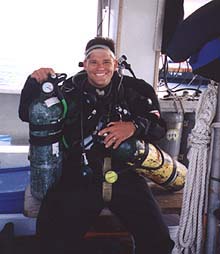
NOAA divers enter the water in hopes of recovering artifacts in the area where the engine was removed. Click image for larger view.
NOAA divers are overjoyed to participate in the Monitor mission. Click image for larger view.
Monitor 2001 - Phase II Ends
July 25, 2001
Dr. John Broadwater, Manager
Monitor National Marine Sanctuary
Jeffrey Johnston, Historian
Monitor National Marine Sanctuary
As reported last week, the recovery of the Monitor's engine went as planned. On July 18, the engine was placed in Dry Dock No. 10 at Newport News Shipbuilding for eventual transfer to The Mariners’ Museum in Newport News, Virginia, where it will undergo a lengthy conservation treatment.
As soon as the engine was safely on its way to Newport News, work resumed on the Derrick Barge Wotan. Surface-supplied divers began rigging the 4-ton condenser for recovery, while saturation divers began to disassemble the segment of armor belt that lies over the turret. The armor belt is a formidable obstacle: it is 5 ft high, almost 3 ft wide, and consists of five 1-in layers of armor plate over a shock-absorbing foundation of oak and pine.
On July 17, a NOAA-funded dive team, operating from the Research Vessel Cape Fear, began working alongside Navy divers. Their role is to map and recover artifacts in the area where the engine was removed, as well as assist Navy divers, if requested. The dive team consists of personnel from the National Undersea Research Center at the University of North Carolina at Wilmington, the Maritime Studies Program at East Carolina University, and private volunteers. NOAA divers will continue their research until August 17; their progress will be reported on this site.
Early in the morning of July 21, during the night shift, excavation within the Monitor's turret revealed a handwheel, castor and eyebolt that Sanctuary Historian Jeff Johnston identified as belonging to one of the Monitor's two gun carriages. This virtually verifies that both 11-inch Dahlgren cannons are still inside. This was one of the principal questions to be answered during this year’s expedition.
On July 22, the Navy salvage tug Apache, with two staff members from the Mariners’ Museum aboard, loaded the cradle that will hold the Monitor's engine, the condenser, and a large metal basket containing a variety of parts associated with the engine, including steam piping, valves, fittings and linkage.
On Monday, July 23, SAT divers succeeded in removing the innermost side armor plate and cutting most of the way through the wood backing. Time did not permit the completion of the cut or removal of the armor belt segment; however, it will be an easy matter to accomplish at the beginning of next season.
On Tuesday, July 24, with all major goals accomplished and the weather deteriorating, the expedition ended one day early. The eight anchors were recovered and the barge began the slow tow to Morehead City, North Carolina, where Navy and NOAA equipment will be removed before the barge returns to the Manson Gulf facility in Houma, Louisiana.
The 2001 expedition is far from over, so please check back for Navy phase wrap-ups and reports from the NOAA team.
Sign up for the Ocean Explorer E-mail Update List.























